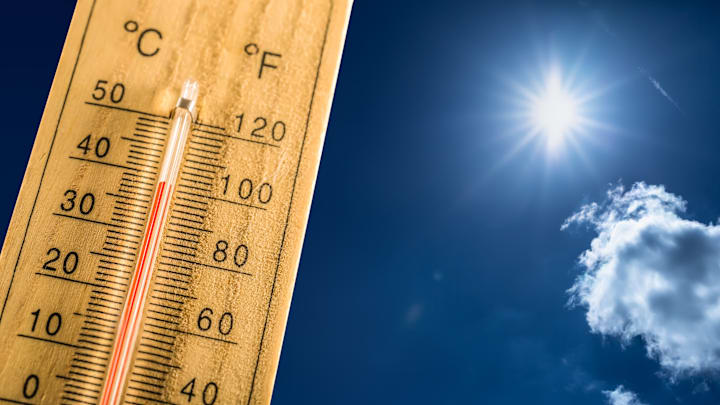You don’t have to be a budding meteorologist to find extreme temperature swings fascinating. In October 2019, Denver made headlines when residents saw a 64-degree fluctuation—from 83 degrees down to 19—inside of a single day. Joggers went from spandex shorts to heavy sweatshirts.
Temperature changes can get even more dramatic when you take a look at the historical record of weather in each state. Recently, media outlet Stacker compiled data from the National Oceanic and Atmospheric Administration (NOAA) to break down the highest and lowest recorded Fahrenheit temperatures through 2021. You may be surprised how warm (and how cold) your local climate has gotten.
State | Highest | Lowest |
|---|---|---|
Alabama | 112 F (1925) | -27 F (1966) |
Alaska | 100 F (1915) | -80 F (1971) |
Arizona | 128 F (1994) | -40 F (1971) |
Arkansas | 120 F (1936) | -29 F (1905) |
California | 134 F (1913) | -45 F (1937) |
Colorado | 115 F (2019) | -61 F (1985) |
Connecticut | 106 F (1916) | -32 F (1943) |
Delaware | 110 F (1930) | -17 F (1893) |
Florida | 109 F (1931) | -2 F (1899) |
Georgia | 112 F (1983) | -17 F (1940) |
Hawaii | 100 F (1931) | 12 F (1979) |
Idaho | 118 F (1934) | -60 F (1943) |
Illinois | 117 F (1954) | -38 F (2019) |
Indiana | 116 F (1936) | -36 F (1994) |
Iowa | 118 F (1934) | -47 F (1996) |
Kansas | 121 F (1936) | -40 F (1905) |
Kentucky | 114 F (1930) | -37 F (1994) |
Louisiana | 114 F (1936) | -16 F (1899) |
Maine | 105 F (1911) | -50 F (2009) |
Maryland | 109 F (1918) | -40 F (1912) |
Massachusetts | 107 F (1975) | -35 F (1943) |
Michigan | 112 F (1936) | -51 F (1934) |
Minnesota | 115 F (1917) | -60 F (1996) |
Mississippi | 115 F (1930) | -19 F (1966) |
Missouri | 118 F (1954) | -40 F (1905) |
Montana | 117 F (1893) | -70 F (1954) |
Nebraska | 118 F (1934) | -47 F (1989) |
Nevada | 125 F (1994) | -50 F (1937) |
New Hampshire | 106 F (1911) | -50 F (1885) |
New Jersey | 110 F (1936) | -34 F (1904) |
New Mexico | 122 F (1994) | -50 F (1951) |
New York | 108 F (1926) | -52 F (1979) |
North Carolina | 110 F (1983) | -34 F (1985) |
North Dakota | 121 F (1936) | -60 F (1936) |
Ohio | 113 F (1934) | -39 F (1899) |
Oklahoma | 120 F (1936) | -31 F (2011) |
Oregon | 119 F (1898 and 2021) | -54 F (1933) |
Pennsylvania | 111 F (1936) | -42 F (1904) |
Rhode Island | 104 F (1975) | -28 F (1942) |
South Carolina | 113 F (2012) | -19 F (1985) |
South Dakota | 120 F (2006) | -58 F (1936) |
Tennessee | 113 F (1930) | -32 F (1917) |
Texas | 120 F (1936) | -23 F (1899) |
Utah | 117 F (1985) | -50 F (1913) |
Vermont | 107 F (1912) | -50 F (1933) |
Virginia | 110 F (1954) | -30 F (1985) |
Washington | 120 F (2021) | -48 F (1968) |
West Virginia | 112 F (1930) | -37 F (1917) |
Wisconsin | 114 F (1936) | -55 F (1996) |
Wyoming | 115 F (1983) | -66 F (1933) |
You’ll notice that 11 states broke their heat record during one specific year: 1936. That’s attributable to a notorious heat wave that swept the country as a result of droughts and poor land management in the Plains, which led to a lack of vegetation and drier conditions.
The data also doesn’t reflect wind chill. Factoring that in, the coldest day in the U.S. wasn’t Alaska’s -80°F freeze in 1971. It was atop Mount Washington in New Hampshire in February 2023, when you could enjoy a brisk climb at -108°F.
[h/t Stacker]
